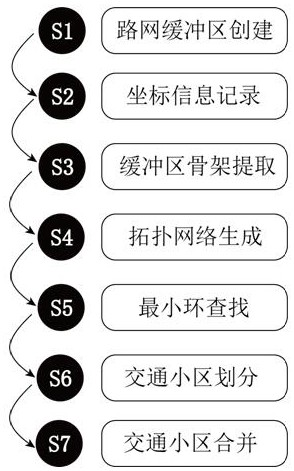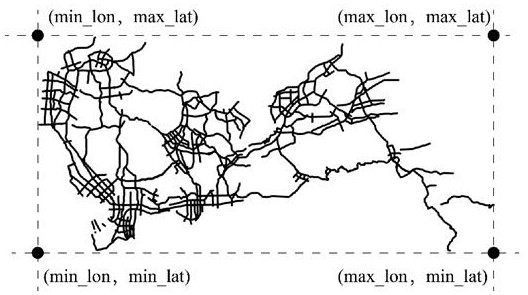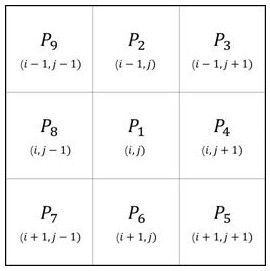System, method, device and storage medium for automatically dividing traffic areas in road network
A traffic area, automatic division technology, applied in the field of intelligent transportation, can solve the problem that the boundary of the traffic area is far from the real road, and it is difficult to apply, and achieve the effect of fast calculation speed, less basic data, and good generalization ability
- Summary
- Abstract
- Description
- Claims
- Application Information
AI Technical Summary
Problems solved by technology
Method used
Image
Examples
Embodiment 1
[0116] Embodiment 1 of the present application provides a system for automatically dividing traffic zones based on image technology (see figure 1 ),include:
[0117] The road network buffer creation module is used to merge the road networks of complex roads, convert linear vector graphics into area domain vector graphics, and store them in a binary image format;
[0118] The coordinate information recording module is used to calculate the longitude and latitude span of the unit pixel of the binary image;
[0119] The central axis skeleton extraction module of the buffer zone, according to the longitude and latitude span of the unit pixel of the binary image, extracts the main line outline of the binary image through iterative calculation to obtain the skeleton image;
[0120] The topological network generation module obtains the topological network based on the skeleton image;
[0121] Find the minimum basic ring module, and use the greedy algorithm to search for the minimu...
Embodiment 2
[0125] Embodiment 2 of the present application provides a method for automatically dividing traffic areas in a road network based on image technology (see Figure 2-Figure 9 ), the method is specifically:
[0126] S1, road network buffer creation,
[0127] The creation of the buffer zone has a relatively important impact on the rationality of the division of the cell. The main purposes of this step are:
[0128] 1) Merge complex roads such as interchanges and multi-line expressways to facilitate the extraction of road centerlines;
[0129] 2) Convert the linear file into a region file and store it as an image format as the input file for extracting the skeleton image.
[0130] The specific steps are:
[0131] Assume that the road network of complex roads has N traffic route links, based on the input road network , the road network information is only required to contain geometric information, and a buffer is created for each link object , convert linear vector graphics ...
Embodiment 3
[0193] Embodiment 3 of the present application provides an electronic device, see Figure 13 , an electronic device in the form of a general-purpose computing device. Components of an electronic device may include, but are not limited to: one or more processors or processing units, memory for storing computer programs that can run on the processors, connections to different system components (including memory, one or more processors or processing unit) bus.
[0194] Wherein, when the one or more processors or processing units are used to run the computer program, execute the steps of the method described in the second embodiment. The types of processors used include central processing units, general purpose processors, digital signal processors, application specific integrated circuits, field programmable gate arrays or other programmable logic devices, transistor logic devices, hardware components or any combination thereof.
[0195] Wherein, the bus refers to one or more o...
PUM
 Login to View More
Login to View More Abstract
Description
Claims
Application Information
 Login to View More
Login to View More - R&D
- Intellectual Property
- Life Sciences
- Materials
- Tech Scout
- Unparalleled Data Quality
- Higher Quality Content
- 60% Fewer Hallucinations
Browse by: Latest US Patents, China's latest patents, Technical Efficacy Thesaurus, Application Domain, Technology Topic, Popular Technical Reports.
© 2025 PatSnap. All rights reserved.Legal|Privacy policy|Modern Slavery Act Transparency Statement|Sitemap|About US| Contact US: help@patsnap.com



